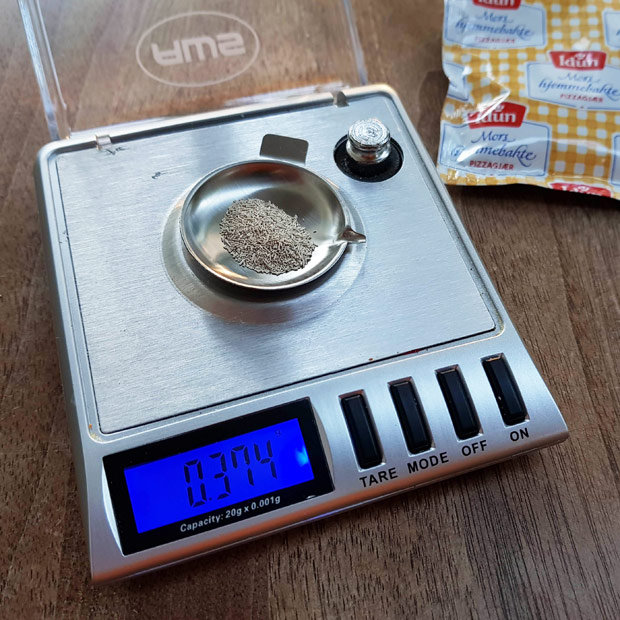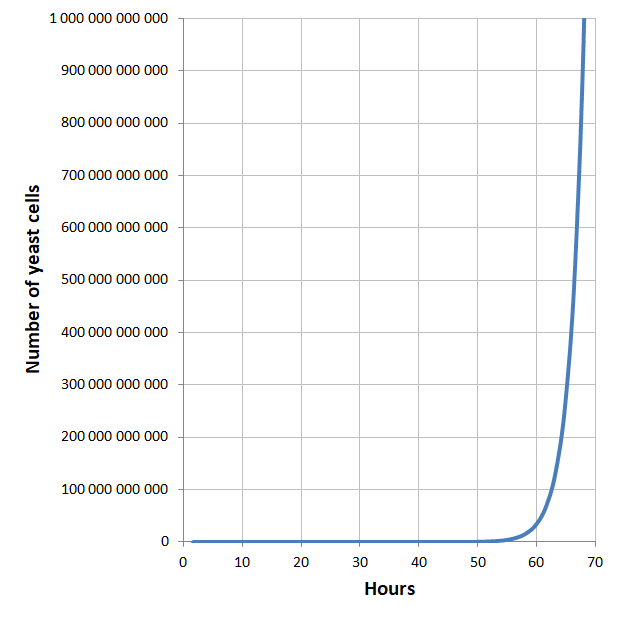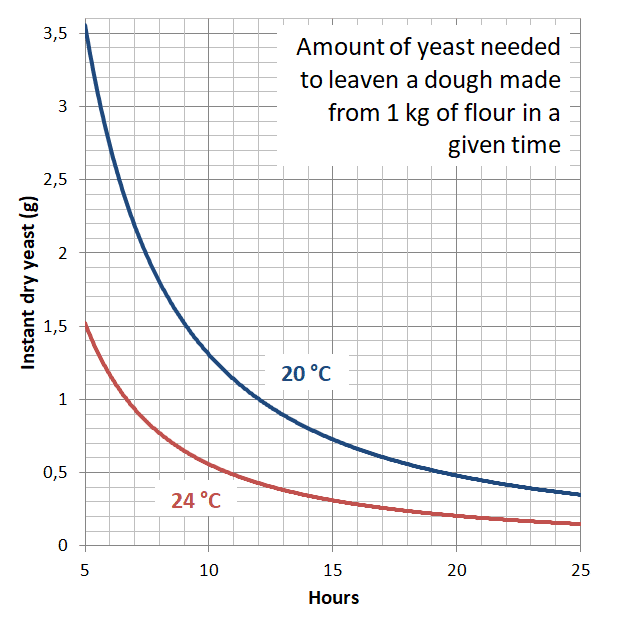
Never before have I seen so many references to exponential growth as during the last year. Regrettably this has been in a negative context related to the spread of the SARS CoV-2 virus. Exponential growth is very counterintuitive (as the wheat/rice chess board problem illustrates). It looks like nothing is happening for a long time. And then all of a sudden a lot happens. This is part of the explanation why COVID-19 cases suddenly seem to skyrocket out of nowhere. On the positive side, many have been left with evenings and weekends free during lockdown, leading to a steep rise in baking with yeast. In Norway where I live, yeast was sold out for weeks and months on end. But I was lucky to never run out of instant dry yeast, due to the exponential growth of yeast.

Exponential growth means that something grows with a fixed percentage over a given period of time. Under ideal conditions with access to nutrients, air and the right temperature a single yeast cell can grow and split into two cells in the course of about 100 minutes – that’s a full life cycle in less than 2 hours. After another 100 minutes the two yeast cells have become 4, and so it continues. After 24 hours there are about 16 000 cells, and after 48 hours we are counting 268 million cells. Before 3 days are gone there are on the order of a trillion yeast cells (1 000 000 000 000). That’s about as many cells as there are in a 50 g piece of compressed yeast. As long as conditions are ideal the growth continues. This can be achieved in commercial production of yeast for a limited amount of time, but in an actual bread dough the process will be a lot slower.

Like everyone else I have also spent more time in the kitchen baking. In order to get more mileage out of each sachet with instant dry yeast I have used a very small amount and rather let time do the work. To help determine the right amount of yeast for a simple bulk fermentation (aka. a direct dough or straight dough, so no preferment such as a poolish, biga, levain etc.) I found the pizza baking app PizzApp+ (for Android) to be of great help. For instance, a dough made with 1 kg of flour needs only 0.48 g of instant dry yeast if left to rise for 20 hours at 20 °C. Small balances that can measure such minute quantities are not too expensive as long as you don’t need laboratory grade equipment. The long bulk fermentation allows some lactic acid bacteria to develop as well, which improves the flavor. The problem with running out of yeast can of course be completely eliminated if you go all in on sourdough, but sometimes the convenience of instant dry yeast is simply too alluring.


Hi Martin, I’ve been wondering about the times given in the PizzApp app myself. Do you trust those estimates? I’m surprised that even modernist bread doesn’t have anything similar to that, so it makes me skeptical 🙂
Great to see you posting again BTW, looking forward to the next version of Textures 🙂
Hi Gianluca: Thank you for commenting! From my experience the times seem OK for overnight leavening, but you are right – this is actually very tricky to do accurately. Even to a simple question such as “How many cells are there in certain amount of yeast” I’ve found estimates ranging from 20 to 100 billion cells/gram dry weight – and they’re probably both right. It really depends.
Some additional factors that complicate calculations:
I’ve found some empirical tables that seem an interesting starting point (like this http://www.thefreshloaf.com/node/5381/sourdough-rise-time-table ). It seem a big jump to assume that once you estimate how active your yeast is compared to his table you can just the same factor everywhere.
In general this seems a very important analysis, but -again- the fact that even the modernist bread folks didn’t provide one makes me more convinced that it’s not that straightforward. Maybe we should ask Francisco Migoya himself 🙂
Interesting table for sour dough there and very informative thread! I like the attempt at standardizing things. Also good that there is a defined end point (i.e. doubling of volume). The table of course is made for one particular sour dough, and the complexity here is that sour doughs are different and they vary over time. Compared to sour dough I think instant dry yeast is much more predictable/reproducible. For sure there will be differences around the world between brands, but variations should be less than for sour dough. BTW I’ve posted a question to Francisco Migoya on Twitter.
I saw your exchange with Migoya. Definitely hydration has an impact, but they could have created different curves for some selected values (or even better, create their own app implementing a more sophisticated model 🙂 )
PizzApp does allow you to change hydration and salt content, but indeed not flour strength. The app is designed for Neapolitan pizza so I’d assume that it expects some “standard” 00 pizza flour like the caputo pizzeria: https://thepizzaheaven.com/caputo-00-flour/
I agree – it would have been great if there was an app to accompany Modernist Bread. Maybe we can hope for this to happen with Modernist Pizza?
By the way have you seen this app https://www.madebywindmill.com/rise/ ? they also have some model to adjust the fermentation time for sourdough based on the dough temperature. I haven’t tried it yet so can’t attest to the quality of their estimates though.
That app is new to me. Like for the other tables you mentioned above I think the greatest uncertainty is the activity of the sour dough you start with. If there was an easy way to standardize the activity it would be so much easier to make sour dough recipes fool proof and more predictable. But speaking for myself, the best place to start is probably just baking more with sour dough 😉
Hi!
I suspect that none of this would be a problem under near-perfect conditions. And here I’m not even talking about sterility or properly formulated nutrient medium and breeding conditions. It’s just that for this experiment to be repeatable, you need yeast and flour of the same brand, the same kind, and the same water, preferably 🙂
It would be interesting to do a similar experiment, just wish I could determine the CFU and provide the data. I just love the idea that for the next 10 years I can make pizzas on one single packet of yeast! Ahahahaha 🙂
I know it’s not exactly what your looking for, but this paper has CFU counts for compressed bakers yeast. It’s a place to start at least!
http://www.journalijar.com/uploads/167_IJAR-4950.pdf